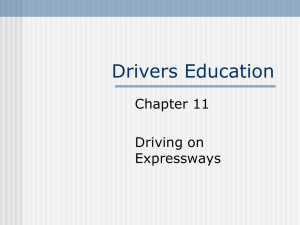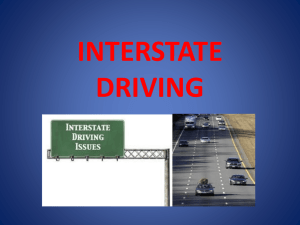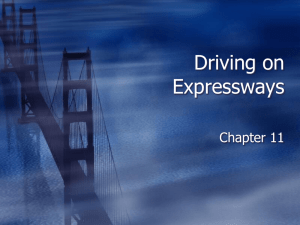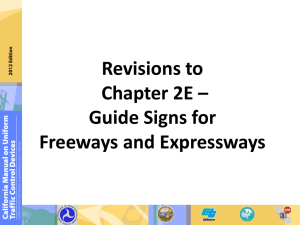Expressway Driving
advertisement
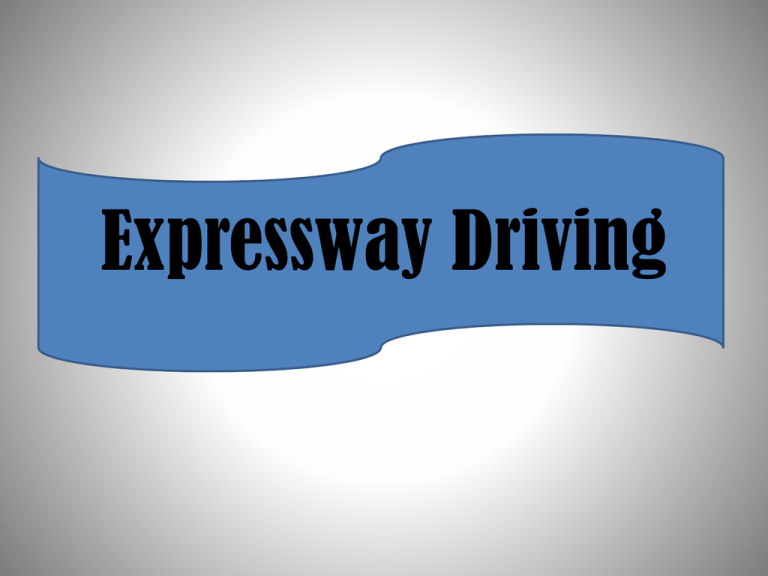
Expressway Driving Characteristics of Expressway Driving Roadway •Interchanges •No cross traffic •Median •Tollbooths •Entrance/exit ramps •Limited access •More lanes Speed •55-65 MPH •Minimum 45 mph •IPDE faster •Predict sudden stop Characteristics of Expressway Driving Other Users No pedestrians Trucks Motorcycles Construction Emergency vehicle Signs & Signals •Green guide signs •Merge •No traffic signals •Interstate signs Advantages to Expressway Driving • • • • • • • Designed for low-risk higher speed travel Safer than other highways No cross traffic Median or barrier separates oncoming traffic Pedestrians & slow moving cars are not allowed Wide shoulders = good escape paths Signs help anticipate conditions early Safe Driving Strategies •Collisions can be more serious •Know where you are going •Obey speed limit or common speed •Build experience gradually •Give full attention to driving task •Cooperate with other drivers 3 Parts of Entrance Ramp See picture in textbook page 225 1. Entrance Ramp 2. Acceleration Lane 3. Merging Area Steps for ENTERING expressway Step # 1 1. Entrance you want ? 2.Is it an entrance? Step # 2 • Check zones • Signal • Check rearview mirror and blind spot Steps for ENTERING expressway Step # 3 • increase speed • check mirrors • check blind spot (just before moving over) Step # 4 • Find TARGET (car) to follow • adjust speed • merge smoothly Step # 5 • Cancel signal • adjust to speed of traffic Randall Rd. and Interstate 90 Randall Road and Interstate 90 Double turn lane to go EAST on 90 off Randall Rd. Entrance from Randall to 90 East Woodfield shopping area Interstate 90 & 53 One example of Entering an Expressway Check the volume of traffic and their speed… (so you’ll know how fast to accelerate) What is the purpose of the first head check…early on ramp? Look for a space to merge in... What is the purpose of the second head check as the ramp begins to straighten? …you are now building up speed - you should also…at this point: …signal, mirror, final head check left …but what will you do if you can not get over because other vehicles are preventing your merge? …make any necessary speed adjustments #5 What other problems might you encounter entering the expressway? a. ramp d. Merging area b. Ramp signal lights e. Entrance on left c. Acceleration lane -- stay back and let him merge…then you can quickly accelerate & complete your merge What if there is a slow moving truck in front of you getting ready to merge? Short merging area, sharp curves Shared entrance and exit Best Lane Choice: Middle/Right Lane Shared entrance and exit Shared entrance and exit Shared entrance and exit How about an entrance on the left?? Best Lane Choice: middle or right lane Scott’s Law (Move Over Law) IPDE • Identify—drivers have longer sight distance, MUST identify volume of traffic, signs & signals EARLY Lane Choice Read section on page 230 You will not be delaying faster traffic If you will be driving slower, why is it best to stay in the right lane? Change lanes Other options: speed up or slow down You are in the right lane and predict a conflict with this merger. If you can, what is your best decision to avoid a conflict? Stay away from mergers If you are moving with the flow of traffic, why is it best to drive in the center lane most of the time? Sometimes there are additional merges to deal with Speed limits •Minimum speed limit Driving too slowly can be dangerous on an expressway, highways have a set lowest speed •Common speed Drive at the common speed used by most drivers so you can blend with expressway traffic, sometimes common speed is higher than maximum speed Lane changing on expressway •Steps for making lane change (page 233) Change one at a time, check mirrors, check blind spot, if path is clear then accelerate and move to next lane, cancel signal •Problems with lane changing—see pictures on page 233 Two cars could be moving into the same open space, traffic in lane you are moving into may be going much faster Exiting Expressway STEPS: page 236 1. at least ½ mile ahead of exit move into the lane that leads to exit, do not reduce speed until you are in deceleration lane 2. move into deceleration lane, cancel signal 3. flash brake lights to warn drivers behind you are slowing, check rear zones 4. identify ramp speed, check your speed, predict a yield sign, a stop sign or signal light at end of exit Make a lane change right! If this driver wants to get off on Palatine Rd. what should they be doing ASAP? We want to exit at the upcoming exit but what else do we need to look for? You do not want to exit at Kirchoff Road… what must you do here? Preparing to exit at Randall Rd A closer look at signs and roadway markings If we are exiting here what should we be doing now? If we are in the left 2 lanes can we still exit? Approaching tollbooth Tollbooth before Randall After tollbooth before Randall Thinking About Not Wearing Your Seatbelt? Construction Video not riding on shoulder heavy traffic Move Over Law (Scott’s Law)
